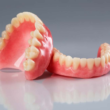In molecular biology, DNA replication is the organic course of of manufacturing two an identical replicas of DNA from one authentic DNA molecule. This course of happens in all residing organisms and is the premise for organic inheritance. The cell possesses the distinctive property of division, which makes replication of DNA important. DNA is made up of a double helix of two complementary strands. Throughout replication, these strands are separated. Every strand of the unique DNA molecule then serves as a template for the manufacturing of its counterpart, a course of known as semiconservative replication. Mobile proofreading and error-checking mechanisms guarantee close to excellent constancy for DNA replication.
In a cell, DNA replication begins at particular places, or origins of replication, within the genome. Unwinding of DNA on the origin and synthesis of recent strands leads to replication forks rising bi-directionally from the origin. A lot of proteins are related to the replication fork to assist in the initiation and continuation of DNA synthesis. Most prominently, DNA polymerase synthesizes the brand new strands by including nucleotides that complement every (template) strand. DNA replication happens through the S-stage of interphase. DNA replication will also be carried out in vitro (artificially, outdoors a cell). DNA polymerases remoted from cells and synthetic DNA primers can be utilized to provoke DNA synthesis at recognized sequences in a template DNA molecule. The polymerase chain response (PCR), a standard laboratory method, cyclically applies such synthetic synthesis to amplify a particular goal DNA fragment from a pool of DNA. DNA normally exists as a double-stranded construction, with each strands coiled collectively to kind the attribute double-helix. Every single strand of DNA is a sequence of 4 varieties of nucleotides. Nucleotides in DNA comprise a deoxyribose sugar, a phosphate, and a nucleobase.
The 4 varieties of nucleotide correspond to the 4 nucleobases adenine, cytosine, guanine, and thymine, generally abbreviated as A,C, G and T. Adenine and guanine are purine bases, whereas cytosine and thymine are pyrimidines. These nucleotides kind phosphodiester bonds, creating the phosphate-deoxyribose spine of the DNA double helix with the nuclei bases pointing inward (i.e., towards the opposing strand). Nucleotides (bases) are matched between strands by means of hydrogen bonds to kind base pairs. Adenine pairs with thymine (two hydrogen bonds), and guanine pairs with cytosine (stronger: three hydrogen bonds).
DNA strands have a directionality, and the totally different ends of a single strand are known as the “3′ (three-prime) finish” and the “5′ (five-prime) finish”. By conference, if the bottom sequence of a single strand of DNA is given, the left finish of the sequence is the 5′ finish, whereas the precise finish of the sequence is the three’ finish. The strands of the double helix are anti-parallel with one being 5′ to three’, and the alternative strand 3′ to five’. These phrases discuss with the carbon atom in deoxyribose to which the subsequent phosphate within the chain attaches. Directionality has penalties in DNA synthesis, as a result of DNA polymerase can synthesize DNA in just one course by including nucleotides to the three’ finish of a DNA strand. The pairing of complementary bases in DNA (by means of hydrogen bonding) signifies that the knowledge contained inside every strand is redundant.
Phosphodiester (intra-strand) bonds are stronger than hydrogen (inter-strand) bonds. This enables the strands to be separated from each other. The nucleotides on a single strand can due to this fact be used to reconstruct nucleotides on a newly synthesized associate strand. All the things wanted to learn about DNA construction and its replication.








